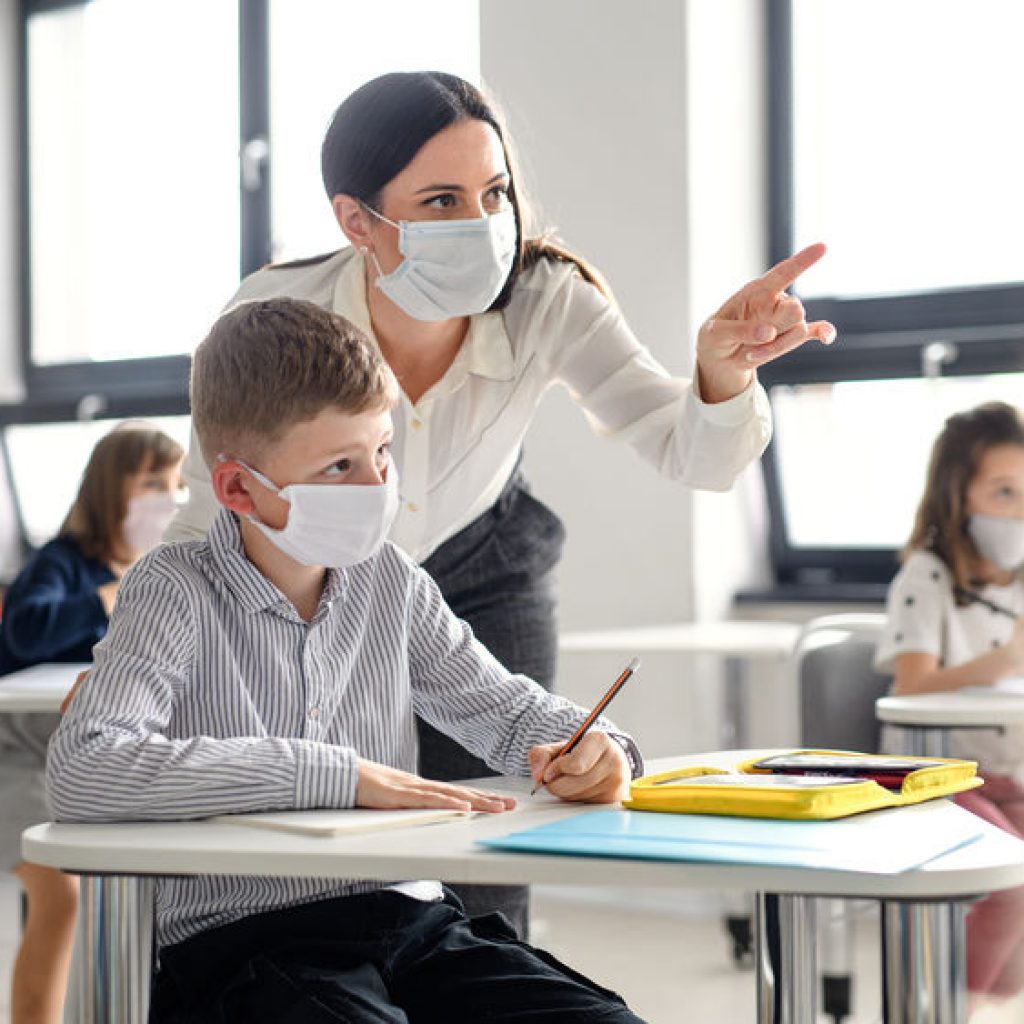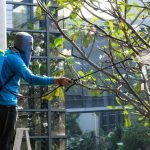CHRISTOPHER MALONEY, ND
In December 2019 I decided to try substitute teaching at our local charter school for the arts. They were hiring a full-time high school science teacher, so I had no pressure and only a few patients I needed to reschedule. When I asked about expectations, I was told I needed to keep the students alive and to not fall asleep at my desk. Simple enough. I taught what I wanted and had a blast. I was a hit, so much so that the students petitioned to hire me full-time. I was flattered but it was out of the question. I declined. After my week there, I said goodbye to my classes, reminding them that the “real” teacher would be starting on Monday.
But over the weekend, I found myself going through the classic stages of grief. In a few short days, I had become invested in the lives of these students far beyond what I expected. To continue meant juggling patients, students, certification requirements, and learning a whole new language of education. But I was up for the challenge.
My students at the Maine Arts Academy (MEAA) are self-selected, artistic students who have created a safe school in Central Maine for the transgender and LGBTQ+ community. Central Maine still has the original quaint roadside barns and 1950s drive-ins because no one has ever updated them. After having lived here for nearly 20 years, I’m just now being grudgingly accepted by my neighbors. Coming out of the closet in Central Maine means waving a rainbow flag in a community where the American flag is the only one that is accepted by most of your classmates and maybe all of your family. But the students at MEAA have found a place where they can be themselves without offending anyone. In one small class, 100% of my students were self-identified as transgender. My percentages in other classes far exceed the estimated 2% for the country as a whole.1
So, part of my daily routine is keeping track of pronouns and name changes. It’s one thing to say that someone is gender-fluid. It’s another thing to go through 3 names and 2 different sets of pronouns in a semester. But I was up for it, keeping a running tally of who was who in a given week.
Then COVID happened.
Into the Fire
I saw COVID coming, monitored the progress of the disease in classes, talked about the vectors, and used it as a starting point to discuss climate change and the decimation of our bat populations by White Nose Syndrome. But I fully expected a public health response equivalent to our 2009 response to the H1N1 Pandemic.
But when I saw the reports coming out of Italy, I started following the mutations of the virus on Nextstrain.org, and told my students in February of 2020 that we were dealing with multiple strains with a very high mutation rate. I still didn’t think we’d close as quickly as we did, but I knew we’d been breached and would need to isolate. It was a temporary stopgap measure, not a permanent solution.
Isolation
My students and I went home to help flatten the curve – not to wait for a vaccine, not to wait for an executive decision that the pandemic was officially over; those were never discussed. All we were doing was going home to slow transmission and to allow our hospitals to keep up. It was supposed to be a 2-week break, not the solution for the pandemic.
Going online and pretending to educate is about as effective as trying to do a physical via Zoom. Sure, some things can transfer, but most cannot. Students are embarrassed by seeing themselves on camera, so they used every excuse to avoid it. We settled on tipping the cameras up to the ceiling. There is nothing quite as surreal as giving a talk on Mendelian genetics to a collection of ceiling fans via Zoom.
A Shaky Foundation
Before COVID, Gen Z already had much poorer mental health than other generations, with around 27% describing fair or poor mental health.2 The rate of poor mental health among the LGBTQ+ and transgender community is likely twice as high.3 Nine in 10 Gen Z adults experienced at least 1 physical or emotional stress before COVID began. Imagine taking this generation and subjecting them to what amounts to house arrest, and even solitary confinement, as their families distance from them out of fear of contagion. Over the past year, my students have all had mental health concerns. The only variation is the level of mental health crisis they are experiencing.
Over the past year, I have experienced the joys and sorrows – oh, the sorrows – of Gen Z as they struggle to come of age while frozen in the amber of quarantine. The interruption of our lives has marked them permanently, changing them to “Generation COVID” before my eyes. When I surveyed my students, most of them described a 70% reduction in their quality of life as a result of the shutdown. In every class, I have at least 1 student who has needed hospitalization over the last year, and half a dozen others who have disappeared from the school entirely.
In the future, we will never again see Gen Zers voluntarily isolate themselves for so long. We took our children and locked them away from their peers, isolating them with often-abusive parents for a year. In April of 2020 as the lockdown hit, reporting of child abuse in the United States had dropped by 40%.4,5 But that doesn’t mean the abuse hasn’t continued behind closed doors. What we did to our children may have been necessary, but preliminary data show that we damaged them in the process.
Some of my students will never recover from COVID isolation. They talk about how much easier it is to just be online. Social contact is embarrassing, troubling, fraught with possible failure. It’s so much easier to stay home with casual online friends and video games, always ready to play or pause whenever you desire. We have created our own hikikomori, the Japanese young people who withdraw from society.6-9 Why go out when everything can be done online?
After a year of mostly distance, I want to be clear about the need for human contact. Developmentally, these high school students have touch hunger, often bordering on touch starvation. They are already in depressed and anxious states, so the required deprivation denies them oxytocin relief and all of its benefits. In the last 2 weeks at MEAA, we had 3 suicide attempts and 2 additional hospitalizations for complete mental exhaustion. These students talk openly about ending it all every day. High school is now 1 part education, 1 part suicide watch. We must recognize that the walking wounded of this pandemic are not just those with chronic COVID, but also every single one of our children.
Teaching In a Time of COVID
The challenges of this year have cost us 4 teachers so far. While first-responders get applauded, adding a camera to the classroom while out-of-work parents watch and judge has created an unbelievable pressure cooker. Parents inevitably passed by at the moment a student was asking about the sexual apparatus of the mallard duck. It made for some interesting parent-teacher Zoom conferences.
It’s not the administration, the bevy of irrelevant standardized tests, the lack of resources, the fear of contracting this plague and expiring, or the students themselves that have driven veteran teachers from the field. The true nightmare of this year has been trying to thread the needle through this political landmine field of a country while keeping an eye on providing a bare facsimile of an educational outline. If there is anything I have learned from this year, it is that I can teach students but I cannot teach their parents.
One of the issues of distance-learning has been that students who had come out at the school may not have come out at home. I already need to keep a running tally of their preferred gender names and pronouns to support their identities and choices. Suddenly, I needed to know whether to call them that name or their birth name when they were in a Zoom classroom because family members might be listening in the background. We solved this by using the chat feature and asking what the pronouns of the day needed to be. But several of my students were forced to come out to their parents during shutdown because it was impossible to maintain 2 identities in the cramped confines of COVID.
We’ve just taken a weird, terrifying yearlong vacation from actual education. Unless we acknowledge this reality, the illusion that a Zoom call equals education may become part of our cultural mythos.
The educational milieu is 1 part lecture, 9 parts social and cultural context. It’s not what I say; it’s how friends react, who puts up their hands, and who makes the whispered side comment that has one table stifling giggles. In class, students learn how to learn, how to interact, how to be alive with their peers in the room. They are creating the culture of tomorrow 1 day at a time.
By comparison, Zoom is just a boring Brady Bunch episode where nothing really happens. Most of my students did me the service of complimenting my morning Zoom podcast while they entertained themselves. I know my naturopathic colleagues have dealt with telemedicine, but that is usually with a motivated, engaged patient. Imagine 15 patients who don’t want to be there, as well as 10 more who may pop in a half-hour late, and you have a sense of an average day in a high school Zoom classroom.
A Call Out to More of Us
And yet, I love it. I love all of it, even when an irate parent Zoom-bombs in and starts shouting down our BLM presenter. I swear every student in my classroom went from bored to riveted. They understand what matters, what really matters.
My school is less a creation of the state or Gen Xer teachers, and much more a creation of alt-Gen Z, making the mad world they live in safe for themselves and each other. I am stunned by the level of compassion and maturity they show each other, even as they largely ignore school work that doesn’t really impact their lives. These may not be the next titans of industry. But they will be the people who are there for each other as we deal with the crises of the future. As they grow as artists, perhaps they will learn to transmit the wisdom that they already have to the rest of us. Only when we learn what they already know about priorities can we hope to step off the empty treadmill of consumer culture and recognize that relationships with things will never fill the needs we have.
How to Teach in the Time of COVID?
You do it by beginning with defeat. Begin with the reality that today will likely be disrupted mid-lesson by an announcement that someone has been in contact with someone who might have COVID and the busses are coming early to bring the students home. Begin with the reality that your 8 AM lecture on the oceans’ benthic layer will be poorly attended, even though it was voted on by your class as one of the lectures they wanted most. The students are sleeping, and some of them really need that more.
Next, add in gratitude – gratitude that some students have dragged themselves out of bed, out of depression, and hauled themselves in front of a screen despite their Zoom anxiety for your class. Every day we connect, with me asking for a word of the day and the answer to a question. Sometimes it’s a question about their greatest fear, or how they would rate their mood today. And sometimes the question of the day and the answers can take up half of the class period. But that’s a good thing, because we’re talking and laughing, connecting through screens because we can’t connect in person. The lesson will wait, and they will understand it more because they are awake and engaged.
Finally, bring in compassion. Every time I found myself wondering why someone was blowing me off, I would find that the story behind the absence was so much worse than I would have thought. A homeless child didn’t have Wifi. Another found his mother dead on the ground and didn’t make it to class. And when your family doesn’t have heat, you use the internet money to pay for fuel. It’s not that learning wasn’t important; it’s that other things were more important. Sometimes what they really needed to do was spend the day trying to stay alive.
I have been marked by teaching during COVID. My long-term patients, who now only see me after school, comment that I seem much more joyful. I find that what I undervalued before – my caring – has finally exceeded my need to be the smartest person in the room.
We are entering a time after COVID, a time when the thick-shelled membrane of our outer selves has been thinned by isolation and distance. It makes us more reactive to each other, but also more sensitive to each other. Now imagine never having thickened your skin, and you have the students at my school. They are children in adult bodies, galumphing around in these oversized shoes like newborn colts first discovering a spring pasture. They are beautiful and wonderful and perfect amid their vast imperfections. Together we rediscover the world. Try a week of substitute teaching – it might change your life as well!
References:
- Schmidt S. 1 in 6 Gen Z adults are LGBT. And this number could continue to grow. February 24, 2021. Washington Post. Available at: https://www.washingtonpost.com/dc-md-va/2021/02/24/gen-z-lgbt/. Accessed April 17, 2021.
- Bethune S. Gen Z more likely to report mental health concerns. Monitor on Psychology. 2019;50(1):20. Available at: https://www.apa.org/monitor/2019/01/gen-z. Accessed April 17, 2021.
- Escobar-Viera CG, Whitfield DL, Wessel CB, et al. For better or for worse? A systematic review of the evidence on social media use and depression among lesbian, gay, and bisexual minorities. JMIR Ment Health. 2018;5(3):e10496.
- Ingram J. Has child abuse surged under COVID-19? Despite alarming stories from ERs, there’s no answer. July 26, 2020. NBC News. Available at: https://www.nbcnews.com/health/kids-health/has-child-abuse-surged-under-covid-19-despite-alarming-stories-n1234713. Accessed April 17, 2021.
- Caron F, Plancq MC, Tourneux P, et al. Was child abuse under detected during the COVID-19 lockdown? Arch Pediatr. 2020;27(7):399-400.
- Teo AR, Gaw AC. Hikikomori, a Japanese culture-bound syndrome of social withdrawal?: A proposal for DSM-5: A proposal for DSM-5. J Nerv Ment Dis. 2010;198(6):444-449.
- Nearchou F, Flinn C, Niland R, et al. Exploring the impact of COVID-19 on mental health outcomes in children and adolescents: A Systematic Review. Int J Environ Res Public Health. 2020;17(22):8479.
- Durkin J, Jackson D, Usher K. Touch in times of COVID-19: Touch hunger hurts. J Clin Nurs. 2021;30(1-2):e4-e5.
- Field T. Touch for socioemotional and physical well-being: A review. Dev Rev. 2010;30(4):367-383. Available at: Touch for socioemotional and physical well-being: A review (radboudcentrumvoormindfulness.nl). Accessed April 17, 2021.

Christopher Maloney, ND teaches sciences at the Maine Arts Academy in Sidney, Maine. He also writes books and sees patients after school. His book, The Colon Cancer Diet, continues to be a source of comfort for his fellow colon cancer survivors. Dr Maloney welcomes any suggestions on what high school students should learn in the sciences. He can be reached at [email protected].





